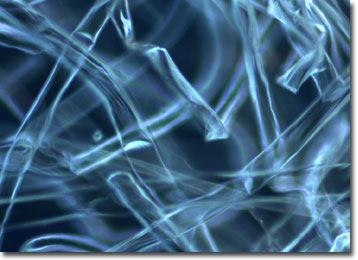Fluorescence Digital Image Gallery
Kapok Fiber
Kapok fiber is a silky cotton-like substance that surrounds the seeds in the pods of the ceiba tree. The ceiba tree belongs to the Bombacacae family and is primarily found in Asia in tropical and semi-tropical climates at an altitude less than 1000 feet, in porous volcanic soil.

The silky kapok fiber, or floss, is actually a tiny cellulose tube with air sealed inside. The material is removed by hand, dried, separated from the seeds and prepared for export. It is too brittle and inelastic to be spun, but it is ideal for stuffing life preservers and other water-safety equipment because of its excellent buoyancy. It can support as much as 30 times its own weight in water and loses only 10 percent of buoyancy over a 30-day period. Kapok fiber is also a popular stuffing for pillows, mattresses, upholstery, sleeping bags, quilts, and jackets because it is lightweight, non-allergic, non-toxic, and odorless. The fiber is an important export of the Indonesian island of Java, and is often referred to as Java cotton. Recently, however, foam rubber, plastics, and man-made fibers have started to replace kapok fiber.
Kapok fiber is not the only part of the ceiba tree that is used for manufacturing products. The seeds of the tree are composed of over 25 percent fatty oil, which is used to make soap and refined to make edible oil. The residue from the seeds and pods is used as fertilizer and cattle feed. The tree also provides a natural habitat for many animals in the rainforest. Spear nose bats drink nectar from the trees' flowers and also play an important role in the pollination process. Harpy eagles live and nest on the top part of the tree, which is known to reach a towering 148 feet. Tree frogs prosper in the protective canopy-like leaves, which provide water pockets for the frogs. Toucans and scarlet macaws live and nest in the middle part of the tree, breaking apart the pods and eating the edible parts. The tree is also an important species for plants like epiphytes (air plants), making the ceiba tree valuable for plants and animals, as well as humans.
The specimen presented here was imaged with a Nikon Eclipse E600 microscope operating with fluorite and/or apochromatic objectives and vertical illuminator equipped with a mercury arc lamp. Specimens were illuminated through Nikon dichromatic filter blocks containing interference filters and a dichroic mirror and imaged with standard epi-fluorescence techniques. The specific filter for the kapok fiber was a DAPI, FITC, Texas Red combination. Photomicrographs were captured with an Optronics MagnaFire digital camera system coupled to the microscope with a lens-free C-mount adapter.
BACK TO THE FLUORESCENCE DIGITAL IMAGE GALLERY
